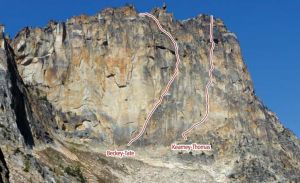Beckey-Tate, Big Kangaroo III 5.9 |
||
Washington Pass, Washington, USA | ||
| ||
|
Avg time to climb route: 3-6 hours
Approach time: 2-4 hours Descent time: 2-4 hours Number of pitches: 7 Height of route: 900' Overview
This is a burly and old school 5.9 for confident 5.9 leaders. While the hardest moves are well-protected, there are some stout and slightly runout 5.8 chimneys. It is the easiest route up the south face of Big Kangaroo, one of the more amazing looking walls in the area. It has three distinct parts. The start of the route is mostly low 5th class climbing up a ramp. The middle of the route has slightly runout and burly chimneys. The final section has finger cracks and technical face climbing and is both the most fun and most difficult. Photos
- View all 1 photos of Beckey-Tate as: Thumbnails | Slideshow
Climber Beta on Beckey-Tate
Find other routes like
Beckey-Tate
Route History
First climbed in 1967 by Fred Beckey and Dan Tate. Their ascent was the first route ever on the massive south face of Big Kangaroo. Beckey had eyed the face for a long time from other nearby features. The wall looked difficult and slightly intimidating except for an obvious weakness slashing across the center of the face. Not much else is known about their ascent. Strategy
Despite being the easiest of all the routes on the south face of Big Kangaroo, the Beckey-Tate is only climbed a handful of times every year. You are likely to have the route to yourself, even on a busy weekend.The first three pitches start with a mix of moderate climbing and the occasional more difficult (up to 5.6) section. The route finding on Pitch 4 is a little bit challenging. You belay below a chimney that seems like the right way to go. Itís not. Instead, climb up, around a corner to the right, and through a group of trees to a different chimney. This chimney is a little runout on 5.7 and 5.8 terrain and brings you to a belay in an alcove. Most climbers break Pitch 5 in half to minimize rope drag going through the crux 5.9 fingers corner. The crux is fun climbing, well-protected, and you could pull through the hardest moves on gear. Below the crux, the left side looks tempting but donít take it; itís more challenging and looser than you think. Pitch 6 is a super fun mix of face and layback moves up a left-facing corner that features a few surprise splitter finger cracks higher up. Above Pitch 6, it is mostly scrambling and low 5th class climbing to the col that divides the south face from the true summit of Big Kangaroo. While you can climb directly to the summit from here, it is NOT recommended. The rock on this side is extremely loose and the protection poor. Instead, drop 200 feet down a scree-filled gully (snow in early season) and then climb up the normal West Face finish on mostly 4th and low 5th with a final, slightly spooky 5.6+ slab. One of the biggest questions of this route is whether or not to leave gear at the base. You certainly need to carry your approach shoes over. It is a long way to the base with a lot of loose, cross country travel back up and over the pass. Sometimes climbers will rack up at the pass, leave their pack, trekking poles, and any unnecessary equipment there, hike to the base and send. The return to this col is about 15 to 30 minutes and the descent relatively pleasant from there. The third and most convenient option is to just go super light to the base of the south face and carry all of your gear up and over the route. This means climbing challenging terrain and a few chimneys with a bigger pack, but it saves you a lot of time and hassle at the end of the day. Sometimes climbers camp below the south face. There is rarely running water, but you can find snow in shady areas for most of the summer. Camping allows for a short start in the morning, but it means youíll have to return to camp at the end of the climb and hike back up and over the central pass on Kangaroo Ridge. Retreat Storm
There are no fixed anchors. You could rappel this route off trees and horns, but you would likely be forced to leave gear. Having two ropes means leaving less gear. There is a fair bit of loose rock, both on the route and on ledges, and rapping down this face would be a scary and hazardous undertaking. The bottom three pitches traverse a lot, but it would be feasible to reverse this or rappel straight down looking for anchors along the way.
Everything You Need to Know About
Washington Pass
Search the internet for beta on
Beckey-Tate
|
Other Routes on Big Kangaroo
|



